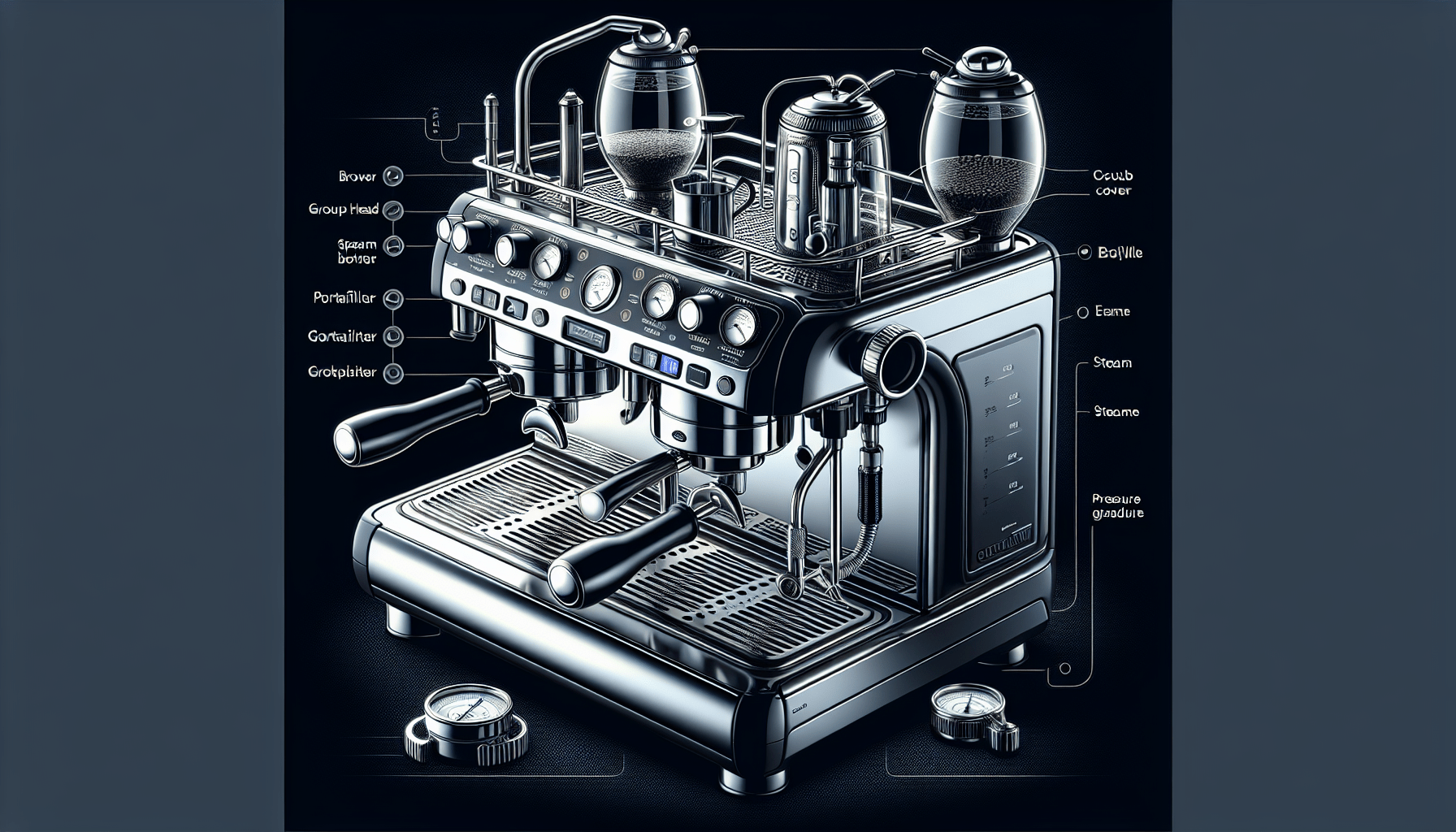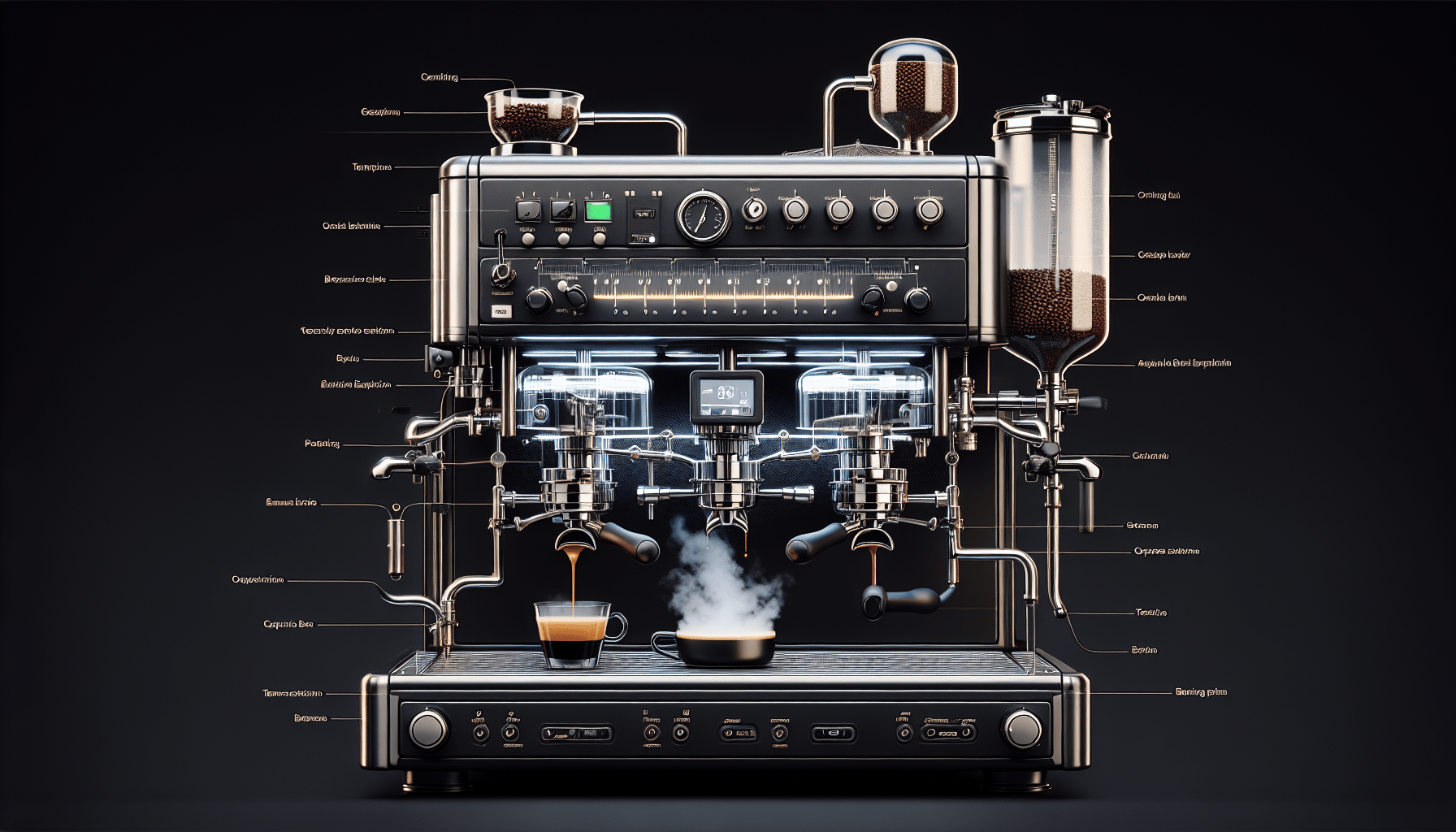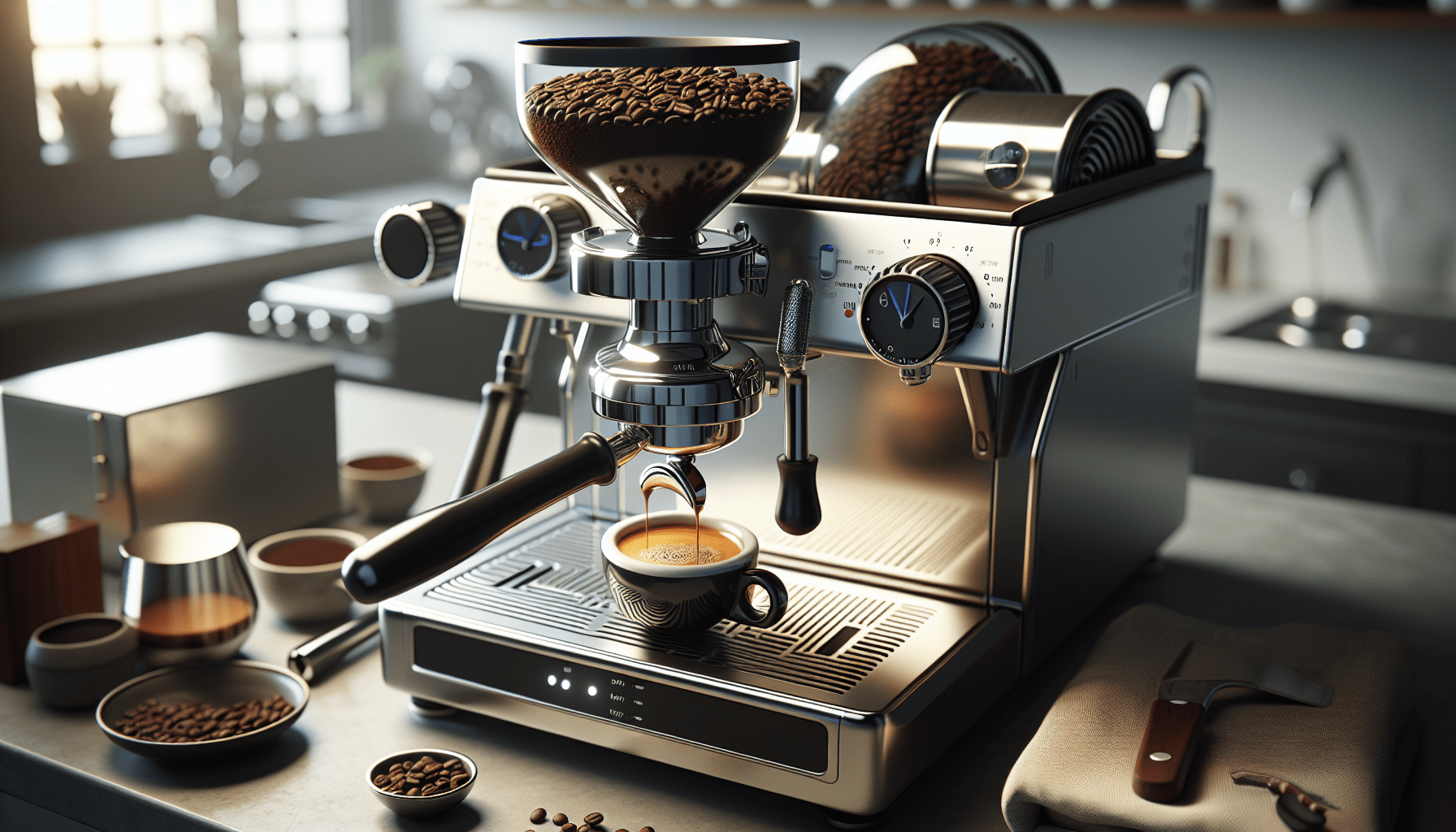So you’ve got a fancy new semi-automatic espresso machine, but you’re not quite sure how it all works. Don’t worry, we’ve got you covered. In this article, we’ll break down the essential components of a semi-automatic espresso machine, giving you a clear understanding of how each part contributes to the perfect cup of joe. From the boiler and group head to the portafilter and steam wand, you’ll be a barista-in-training in no time. So grab your favorite mug and get ready to become an espresso expert!
Boiler
The role of the boiler
In a semi-automatic espresso machine, the boiler serves a crucial role in the brewing process. It is responsible for heating and maintaining the temperature of the water used to extract the espresso shot. The boiler ensures that the water reaches the optimal temperature for brewing, enhancing the flavor and aroma of the coffee.
Types of boilers
There are two common types of boilers used in semi-automatic espresso machines: single boiler and dual boiler.
-
Single boiler: This type of boiler performs multiple functions. It heats water for brewing espresso and also produces steam for milk frothing. However, the drawback is that you cannot brew and steam simultaneously due to the limited capacity of the single boiler.
-
Dual boiler: As the name suggests, a dual boiler machine has separate boilers for brewing and steaming. This allows you to perform both tasks simultaneously, making it more convenient for those who want to brew multiple cups of espresso or enjoy milk-based drinks like cappuccinos or lattes.
Boiler capacity
The capacity of the boiler is an important consideration when choosing a semi-automatic espresso machine. It determines how much water the boiler can hold and how quickly it can recover after brewing or steaming. A larger boiler capacity is beneficial if you have a high demand for espresso or if you frequently make multiple drinks in quick succession. On the other hand, if you are an occasional espresso drinker, a smaller capacity boiler may be sufficient.
Optimal boiler temperature
The optimal temperature of the boiler plays a crucial role in extracting the perfect shot of espresso. Generally, the ideal temperature for brewing espresso falls between 195°F and 205°F (90°C and 96°C). This range allows for the proper extraction of the coffee’s flavor compounds without scorching the beans or producing a weak, under-extracted shot. Many semi-automatic espresso machines offer temperature control options, allowing you to adjust the boiler temperature to meet your personal preferences and the characteristics of the coffee you’re using.
Pump
Function of the pump
The pump is responsible for pushing water through the coffee grounds in the portafilter, creating the pressure necessary for proper extraction. In a semi-automatic espresso machine, the pump plays a vital role in achieving the desired flavors and aromas in the espresso shot.
Types of pumps
There are two main types of pumps used in semi-automatic espresso machines: vibratory pumps and rotary pumps.
-
Vibratory pumps: These pumps use electromagnetic solenoids to generate the necessary pressure for extraction. They are relatively more affordable and commonly found in home espresso machines. Vibratory pumps are known for their reliability and compact size, making them a popular choice for entry-level espresso enthusiasts.
-
Rotary pumps: Rotary pumps are more commonly found in commercial espresso machines due to their higher performance and reliability. They use a motor-driven rotary vane to generate pressure. This type of pump provides a consistent and controllable flow rate, allowing for precise control over the extraction process.
Pump pressure
The pressure produced by the pump is measured in bars and plays a crucial role in espresso extraction. The industry standard for espresso extraction is 9 bars of pressure. This pressure, combined with the right grind size and extraction time, ensures that the coffee flavors are properly extracted without over-extraction or under-extraction. Many semi-automatic espresso machines have built-in pressure gauges that allow you to monitor the pump pressure and make adjustments as needed for optimal extraction.
Portafilter
Definition of a portafilter
The portafilter is one of the most recognizable components of an espresso machine. It is a handle with a basket attached at the end, where the ground coffee is placed for brewing. The portafilter is responsible for holding the coffee grounds during extraction and ensuring proper water flow through the coffee bed.
Different types of portafilters
There are mainly three types of portafilters used in semi-automatic espresso machines: pressurized portafilters, non-pressurized portafilters, and bottomless (naked) portafilters.
-
Pressurized portafilters: Pressurized portafilters feature a special design that incorporates a pressure-release valve. This valve helps to compensate for inconsistencies in grind size or tamping pressure, making it easier to achieve a decent extraction. Pressurized portafilters are often recommended for beginners or those who want a more forgiving brewing process.
-
Non-pressurized portafilters: Non-pressurized portafilters do not have a pressure-release valve. They require more precision in grind size, tamping pressure, and distribution to achieve optimal extraction. Non-pressurized portafilters are favored by experienced baristas who value control over the extraction process and want to explore the nuances of different coffee beans.
-
Bottomless (naked) portafilters: Bottomless portafilters, as the name suggests, lack a spout on the bottom. This design allows you to observe the extraction process and identify any channeling or uneven flow right away. Bottomless portafilters are commonly used by professional baristas who want to perfect their espresso technique and troubleshoot any brewing issues.
Portafilter size
Portafilters come in varying sizes, typically ranging from 50mm to 58mm in diameter. The size of the portafilter determines the amount of coffee the basket can hold and affects the extraction parameters. A larger portafilter allows for a greater coffee dose, which can result in a more intense and flavorful shot. However, it’s essential to consider the size of the espresso machine and your individual brewing needs when selecting the appropriate portafilter size.
Importance of a properly fitting portafilter
A properly fitting portafilter is essential for consistent and efficient extraction. It ensures a secure and tight fit onto the grouphead, preventing any water leakage that could compromise the brewing process. Additionally, a snug fit helps maintain a consistent flow rate through the coffee grounds, producing a balanced and well-extracted espresso shot. It is crucial to ensure that the portafilter is compatible with the espresso machine to avoid any potential issues during the brewing process.
Grouphead
What is a grouphead
The grouphead is the part of the espresso machine where the portafilter attaches. It serves as the gateway for water to pass from the boiler and into the coffee grounds. The grouphead distributes hot water evenly over the coffee bed, ensuring thorough extraction and the creation of a quality espresso shot.
Types of groupheads
There are mainly two types of groupheads found in semi-automatic espresso machines: saturated groupheads and saturated brew groups.
-
Saturated groupheads: Saturated groupheads are heated directly by the boiler, allowing for precise temperature control and stability during extraction. This type of grouphead is commonly found in higher-end espresso machines and is favored by professional baristas due to its ability to maintain consistent temperature throughout the brewing process.
-
Saturated brew groups: Saturated brew groups are a variation of the saturated grouphead design. They are heated indirectly through heat exchangers or thermosyphons, ensuring a constant and stable temperature during extraction. While not as precise as saturated groupheads, saturated brew groups still provide good temperature stability and are commonly found in mid-range espresso machines.
Temperature stability
Temperature stability is crucial for producing consistent and high-quality espresso. The grouphead, in combination with the boiler, plays a significant role in maintaining a stable temperature throughout the brewing process. Fluctuations in temperature can lead to over-extraction or under-extraction, resulting in an imbalanced and less flavorful shot. Look for espresso machines with well-insulated groupheads and precise temperature control systems to ensure optimal temperature stability.
Pre-infusion capability
Some espresso machines come equipped with a pre-infusion feature in the grouphead. Pre-infusion involves briefly saturating the coffee grounds with a low-pressure water flow before full-pressure extraction. This process allows the coffee to bloom, releasing trapped gases and facilitating an even extraction. Pre-infusion helps to enhance the flavor and aroma of the espresso shot, resulting in a more enjoyable and well-balanced cup of coffee.
Steam Wand
Purpose of the steam wand
The steam wand is a fundamental component of an espresso machine, responsible for frothing milk and creating the velvety texture desired in milk-based drinks like cappuccinos and lattes. It emits steam under pressure, allowing you to control and manipulate the milk’s temperature and achieve the desired consistency for latte art or flavor extraction.
Different steam wand designs
There are mainly two designs of steam wands used in semi-automatic espresso machines: single-hole steam wands and multi-hole steam wands.
-
Single-hole steam wands: Single-hole steam wands have a small hole at the end from which the steam is released. These steam wands provide a more focused stream of steam, allowing for more precision while frothing milk. They are often preferred by experienced baristas who want maximum control over the milk texture.
-
Multi-hole steam wands: Multi-hole steam wands have multiple small holes distributed along the length of the wand. This design creates a wider dispersion of steam and is generally easier to use for beginners. Multi-hole steam wands are known for their ability to create a smooth and creamy microfoam quickly, making them suitable for those who prioritize efficiency and convenience.
Steam pressure
The steam pressure generated by the espresso machine is an important factor when frothing milk. It determines the speed and ease with which the steam wand creates the desired milk texture. Most semi-automatic machines produce steam at around 1 to 1.2 bars of pressure, which is generally sufficient for creating silky microfoam. However, some higher-end machines may offer adjustable steam pressure, allowing you to customize the frothing process according to your preferences and the type of milk being used.
Frothing milk
Frothing milk is an art that can greatly enhance the coffee-drinking experience. The steam wand gives you the ability to create different milk textures, from creamy microfoam to airy foam for more decorative latte art. Achieving the desired milk consistency requires practice and an understanding of the milk’s behavior under steam pressure. With the right technique and control over steam pressure, you can create beautifully textured milk that complements your espresso perfectly.
Controls
Control options
Semi-automatic espresso machines offer various control options that allow you to customize your brewing experience. These controls enable you to adjust parameters such as water temperature, extraction time, and pressure. Common control options found in semi-automatic machines include buttons, dials, and switches for activating the pump, adjusting temperature, and activating pre-infusion.
Programmability
Many modern semi-automatic espresso machines feature programmable settings that allow you to save your preferred brewing parameters for easy and consistent use. These programmable settings typically include water temperature, brew time, and pre-infusion duration. By programming your preferred settings, you can ensure that each shot of espresso is brewed exactly to your liking, reducing the need for manual adjustments.
Temperature control
Temperature control is essential for achieving optimal extraction and flavor development in espresso. Some semi-automatic espresso machines provide precise temperature control through adjustable thermostats or digital temperature displays. Having the ability to control and fine-tune the water temperature according to the coffee beans used can lead to a more consistent and flavorful espresso experience.
Pressure control
Pressure control allows you to adjust the pump pressure during extraction, giving you greater control over the brewing process. Some semi-automatic espresso machines offer pressure profiling, which allows you to adjust the pressure curve throughout the extraction to highlight different flavor characteristics in the coffee. This level of control can result in nuanced and complex espresso shots, making it a desirable feature for coffee enthusiasts who enjoy experimenting with different flavor profiles.
Grinder
The importance of a good grinder
A high-quality grinder is crucial for achieving a consistently delicious espresso. The grinder plays a significant role in determining the grind size, which directly affects the rate of extraction and the flavors extracted from the coffee beans. A good grinder ensures an even and uniform grind size, allowing for optimal extraction and avoiding any unpleasant flavors that may arise from unevenly ground coffee.
Types of grinders
There are two main types of grinders used in semi-automatic espresso machines: burr grinders and blade grinders.
-
Burr grinders: Burr grinders are the preferred choice for espresso due to their ability to provide a consistent and precise grind size. They feature two rotating abrasive surfaces (burrs) that crush the coffee beans to a specific particle size. Burr grinders offer greater control over the grind size and produce minimal heat, preventing any potential damage to the coffee beans’ flavor compounds.
-
Blade grinders: Blade grinders use motor-driven blades to chop the coffee beans into smaller pieces. While blade grinders are more affordable and widely available, they often produce an inconsistent grind size, resulting in uneven extraction and a less flavorful espresso. Blade grinders generate heat during grinding, which can negatively impact the coffee’s taste. Therefore, when aiming for a high-quality espresso, a burr grinder is highly recommended.
Grind size adjustments
The grind size is a critical factor in espresso extraction. Different brewing methods require specific grind sizes, and achieving the correct grind size ensures optimal flavor extraction. Semi-automatic espresso machines should have grind size adjustments that allow you to fine-tune the grind according to the beans used and personal preferences. This feature enables you to experiment and optimize the extraction process, leading to the best possible cup of espresso.
Consistency in grind
Consistency in grind is vital for a consistent extraction and flavor profile. An even grind size ensures that the water extracts coffee from all the grounds uniformly, resulting in a balanced and flavorful shot. Inconsistent grind sizes can lead to over-extraction of finer particles and under-extraction of larger particles, resulting in an imbalanced espresso shot with bitterness or sourness. Investing in a high-quality burr grinder ensures a consistent grind size from shot to shot, enhancing the overall coffee experience.
Water Reservoir
Role of the water reservoir
The water reservoir is where the espresso machine stores the water used for brewing espresso. The reservoir is an essential component, as it supplies the machine with the necessary water for extraction. It provides convenience by eliminating the need to connect the espresso machine directly to a water source, allowing you to place the machine anywhere within reach of an electrical outlet.
Size and capacity considerations
The size and capacity of the water reservoir are important factors to consider when purchasing a semi-automatic espresso machine. The size of the reservoir determines how much water it can hold, thus affecting the frequency at which it will need to be refilled. For heavy espresso drinkers or commercial settings, a larger water reservoir is preferred to minimize the need for frequent refills. However, it is important to also consider the available counter space and the overall size of the machine when choosing the appropriate reservoir size.
Water filtration
Water quality plays a significant role in the taste and overall quality of your espresso. Many semi-automatic espresso machines offer built-in water filtration systems to remove impurities and ensure a clean and flavorful brew. These filtration systems can vary in type and effectiveness, ranging from simple charcoal filters to more advanced systems that remove minerals and adjust water hardness. Investing in an espresso machine with a reliable water filtration system can greatly enhance the taste and aroma of your espresso.
Ease of cleaning
The water reservoir should be easy to clean and maintain to ensure the longevity and hygienic use of the espresso machine. Look for models with removable reservoirs that can be easily accessed and cleaned. Additionally, some machines may have built-in indicators or alerts to remind you when it’s time to clean or descale the reservoir, simplifying the maintenance process and helping to preserve the machine’s performance.
Drip Tray
Functions of the drip tray
The drip tray is designed to catch any excess water, espresso, or condensation that accumulates during the brewing process. It serves multiple functions, including preventing spills, keeping the countertop clean, and providing a convenient place for discarding used coffee pucks or cleaning accessories.
Design and capacity
Drip trays come in various designs and sizes, depending on the espresso machine model. The design of the drip tray should take into consideration practicality, ease of cleaning, and aesthetic appeal. Look for drip trays with removable components to facilitate cleaning and maintenance. The capacity of the drip tray should be sufficient to accommodate the level of use and prevent overflow, avoiding any mess or potential damage to the machine.
Ease of cleaning
Cleaning the drip tray should be a straightforward process, as it is an integral part of maintaining hygiene and cleanliness in your espresso machine. Opt for espresso machines with easily removable drip trays and components that can be cleaned separately. Some models may also feature drip trays with indicators that notify you when it’s time to empty or clean the tray, simplifying the maintenance routine.
Cup Warmer
Purpose of a cup warmer
A cup warmer is a feature commonly found in semi-automatic espresso machines that keeps your cups at an ideal temperature. By pre-warming the cups, you can help maintain the optimum temperature of your coffee for a longer period. Warm cups also assist in preserving the integrity of the crema, enhancing the overall presentation and taste of your espresso.
Different cup warming methods
Semi-automatic espresso machines employ various cup warming methods to achieve the desired cup temperature. Some machines feature passive cup warmers, which rely on the heat generated by the boiler or other components to warm the cups. Others may have active cup warmers that include dedicated heating elements to ensure a consistent and controlled cup temperature. The method used can vary depending on the specific machine, and it’s important to consider your personal preferences and the size of your cup inventory when choosing an espresso machine with cup warming capabilities.
Temperature control
Controlling the cup temperature is essential to maintaining the quality and taste of your espresso. Some semi-automatic espresso machines provide temperature control settings specifically for the cup warmer. This feature allows you to adjust the cup warming temperature according to your preferences and the type of coffee being brewed. Having control over the cup temperature ensures a consistent and enjoyable coffee experience from the first sip to the last.
Understanding the essential components of a semi-automatic espresso machine can greatly enhance your brewing experience and help you achieve barista-quality espresso at home. By considering the role and characteristics of each component, you can make an informed decision when selecting an espresso machine that meets your specific needs and preferences. From the boiler to the cup warmer, every component plays a vital role in delivering a delicious and satisfying cup of espresso. So, go ahead and explore the world of semi-automatic espresso machines, and start brewing your perfect shot today!




